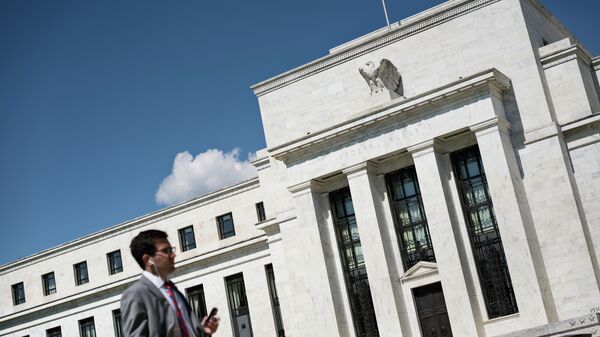Kristian Rouz — After stock markets posted major declines earlier this year, and corporate earnings were slashed by an unlucky combination of overseas risks and domestic policies for at least two quarters straight, the US economy might be heading for an overall recession, and recent labor market data has provided early evidence of such a scenario being indeed possible. The pace of US employment, previously at an optimistic 200,000 new payrolls per month, has started losing steam in recent weeks, as indicated by temporary employment rolling off its late 2015 peak in Q1 this year.
As evidenced by at least two recessions of the past — in 2001 and 2009, both preceded by declines in temp employment — this time around the situation might repeat as well. Private sector enterprises are running out of disposable capital, preventing them from hiring new personnel. Temporary employees are traditionally first in line for broader layoffs, suggesting declines in overall business activity in the near-term.
"I am a little concerned," Bob Funk of Express Employment Professionals said. "Our industry is always on the front end of a recession." Express Employment Professional provides temporary personnel to various businesses.
According to a report by Bureau of Labor Statistics, the number of non-farm temporary help employees dropped to 2,887,900 jobs in February from 2,900,300 the previous month, and 2,944,100 in December 2015. December figures indicated the highest number of temp help jobs since the bottom of recession in mid-2009 at 1,747,400 such jobs in August that year.
Meanwhile, the US Federal Reserve's broader labor market conditions index, tracking 19 industries, including temporary workers, has been falling three consecutive months, and is now in the negative territory, at —2.1 in February compared to —2.5 the previous month and 0.4 positive in December. In November last year, the Fed index stood at 2.9 after five consecutive months of gains.
The 2001 recession was preceded by a six-month decline in Fed index, and the 2008 recession — by 5 months.
Part of the reason for layoffs in temp personnel is rising wages, leaving employers little choice but cut labor costs by other means, eliminating non-regular staff. The Democrat-backed push for raising minimum wage is bucking the trend on jobs elimination, particularly so amidst shrinking corporate and broader private sector earnings.
A looming recession might be also explained by cyclical factors, with the US economy sliding into a period of contraction every 7-9 years, with last recession having ended in 2009-2010. This is a prevailing viewpoint among US economic policy makers, with ex-Secretary of the Treasury Lawrence Summers having said on 15 April the "odds are significantly better than 50-50 that we will have a recession within the next three years."
Official US GDP data is hardly encouraging. Earlier this month, the Federal Reserve Bank of Atlanta downgraded its outlook on Q1 economic growth to just 0.1% positive from the previously forecast 2-2.5% expansion.
In the corporate world, the decline in oil prices and international trade profitability has hurt US energy, utilities, financial services and manufacturing among other sectors. January's Wall Street slump triggered a wave of share buyback by enterprises in attempt to restore their market value. Subsequently, Q1 earnings turned out to be a bigger frustration, and it is most likely that corporate earnings will have declined for three quarters straight by the time this earnings season is over.
"You have had the oil price fallen dramatically and of course the drillers, the shale — these guys have had profit hits there," Nik Nelson of UBS Wealth Management said. "We have gone really nowhere in the last 12 to 18 months in U.S. profits but that doesn't necessarily mean the economy is in recession."
On the brighter side, a possible stabilization and subsequent gains in oil prices, influx of capital in US stocks, and excessive governmental investment in the real economy might stave of recession risks throughout this year, yet, in macro indicators, there are first signs of a contraction in economy being on its way.





